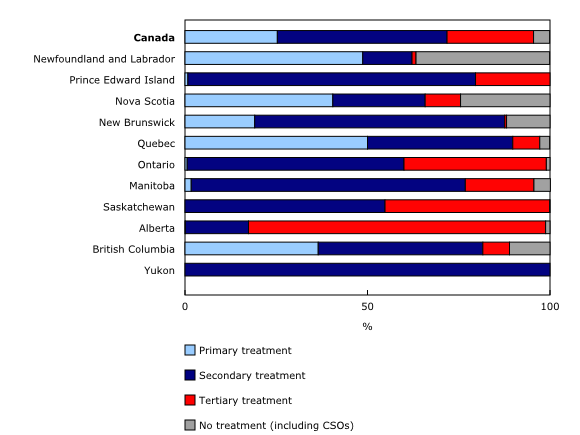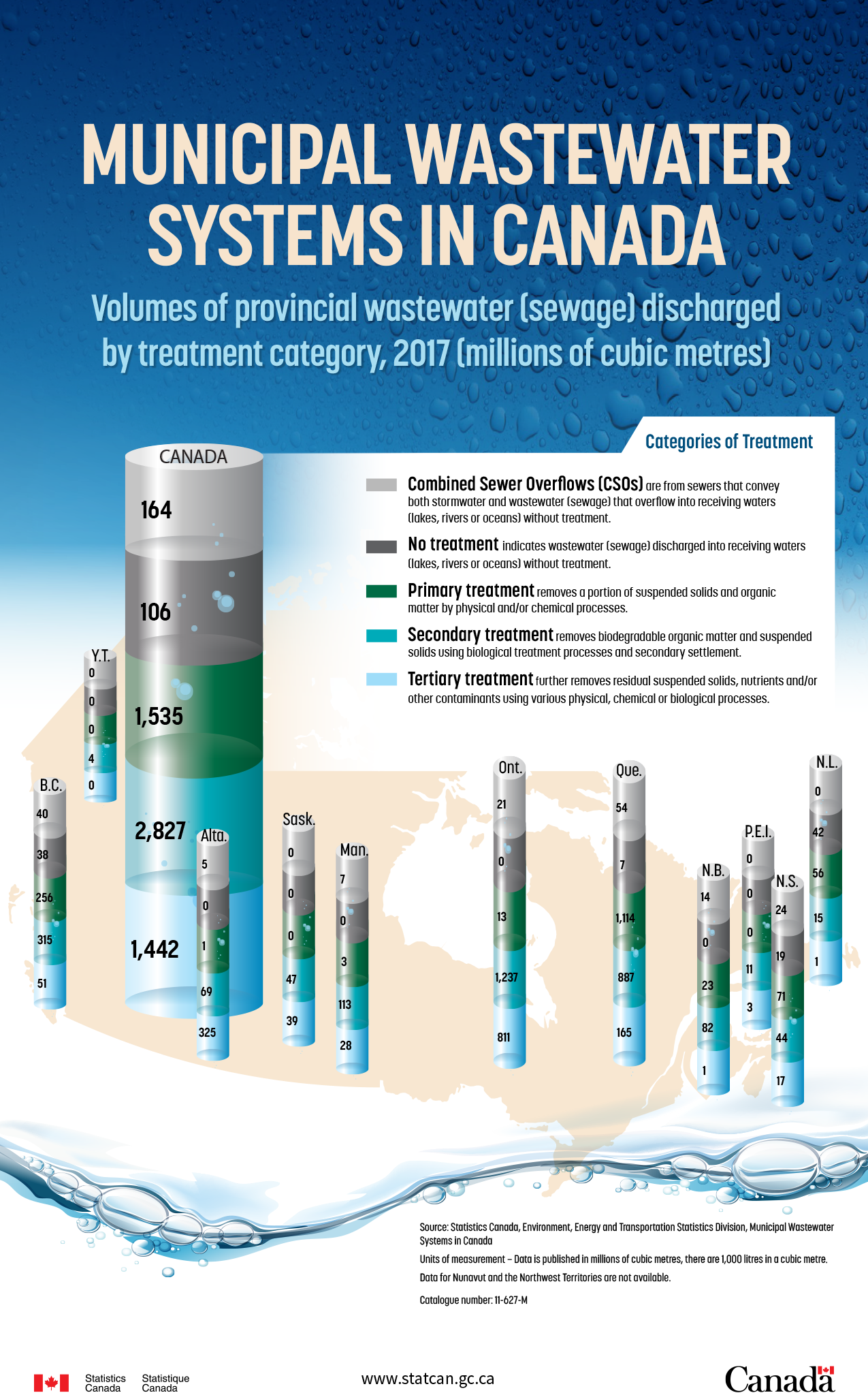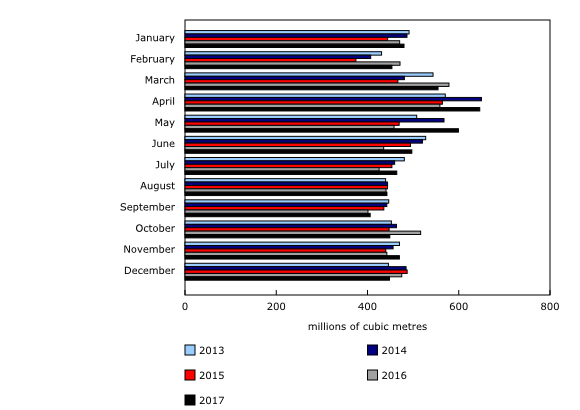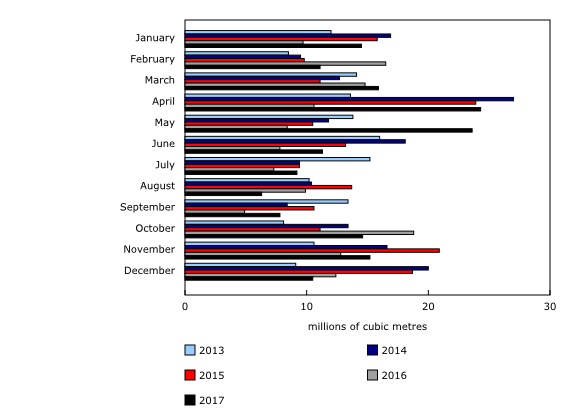Municipal wastewater systems in Canada, 2013 to 2017
Archived Content
Information identified as archived is provided for reference, research or recordkeeping purposes. It is not subject to the Government of Canada Web Standards and has not been altered or updated since it was archived. Please "contact us" to request a format other than those available.
Released: 2019-06-25
Wastewater (sewage) volumes
Just over 5 900 million cubic metres of sewage flowed through municipal wastewater systems in Canada that processed 100 cubic metres per day or more of sewage in 2017, equivalent to the volume of water that flows over Niagara Falls over a 24-day period. These systems receive sewage discharged from residential, industrial, commercial and institutional sources. The volume also includes storm water that enters the collection pipes which convey the wastewater to treatment plants before discharge to surface water sources such as lakes, rivers or oceans.
An additional 164 million cubic metres were discharged from combined sewer overflows in 2017. Combined sewer systems convey both storm water and sewage to wastewater treatment plants. Many of these systems have multiple overflow structures that may discharge untreated sewage mixed with storm water into receiving waters when full capacity has been reached during intense rainfalls.
Vast majority of wastewater is treated before it is discharged
The volume of wastewater discharged varied by the category of treatment. In 2017, 1 535 million cubic metres were discharged from primary treatment systems, which removes a portion of suspended solids and organic matter by physical and/or chemical processes.
Secondary treatment systems, which remove biodegradable organic matter and suspended solids using biological treatment processes and secondary settlement, processed 2 827 million cubic metres.
Tertiary systems, which further remove residual suspended solids, nutrients and/or other contaminants using various physical, chemical or biological processes, released 1 442 million cubic metres.
Systems that provide no treatment discharged 106 million cubic metres of wastewater back into the environment.
In 2017, the total volume of untreated wastewater from combined sewer overflows and systems that provided no treatment reached 270 million cubic metres, or 4.4% of all wastewater collected and discharged by municipal wastewater systems in Canada, equivalent to just over one day of water flowing over Niagara Falls. In 2016, the volume of untreated wastewater discharged amounted to 233 million cubic metres, or 4.0% of the total volume conveyed by municipal wastewater systems in Canada.
British Columbia (78 Mm³), Quebec (61 Mm³), Nova Scotia (43 Mm³), Newfoundland and Labrador (42 Mm³), Ontario (21 Mm³) and New Brunswick (14 Mm³) accounted for the majority of the 270 million cubic metres of untreated wastewater.
Just over 30 million Canadians are served by municipal wastewater systems
In 2017, just over 30 million people were served by municipal wastewater systems that have daily flows that process 100 cubic metres per day or more. Primary treatment systems served 4.8 million people, secondary treatment systems processed wastewater for 15.1 million people, while 9.8 million Canadians were served by tertiary treatment systems. Over 600,000 people discharged their wastewater into systems that provide no treatment. The remaining five million Canadians either had their own on-site wastewater system or were served by other systems with daily flows of less than 100 cubic metres per day, or by other facilities outside the scope of the survey.
Wastewater (sewage) volumes generally peak in April
Monthly volumes of wastewater collected and discharged from municipal wastewater systems increased during spring snow melt from 2013 to 2017. Weather events can increase the volumes collected by municipal wastewater systems as storm water seeps into the collection systems or is collected with sewage in combined sewers. From 2013 to 2017, the largest monthly volumes have occurred in April, except in 2016 when it peaked in March.
Monthly combined sewer overflow volumes
Similar to wastewater flows, monthly combined sewer overflow volumes were typically highest in the spring months from 2013 to 2017, with the exception of 2016, which had peak flows in the fall (October). Factors such as climate, extreme weather events and the state of infrastructure can account for differences in monthly combined sewer overflow volumes across Canada from year to year.
Note to readers
The target population is composed of municipal wastewater systems in Canada with a daily flow of 100 cubic metres per day or more, representing a population of approximately 2,000 systems. These estimates exclude systems that service First Nations reserves, government institutions, commercial and industrial establishments, and provincial parks.
Products
The infographic "Municipal Wastewater Systems in Canada, 2017" is now available as part of Statistics Canada – Infographics (11-627-M).
Contact information
For more information, or to enquire about the concepts, methods or data quality of this release, contact us (toll-free 1-800-263-1136; 514-283-8300; STATCAN.infostats-infostats.STATCAN@canada.ca) or Media Relations (613-951-4636; STATCAN.mediahotline-ligneinfomedias.STATCAN@canada.ca).
- Date modified:





